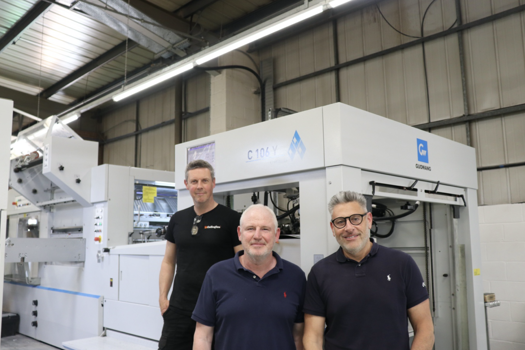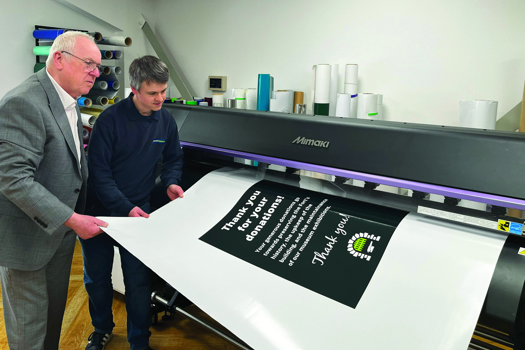This time last year marketing and technology pundits were confidently predicting that 2017 would be the year that virtual reality (VR) and augmented reality (AR) really hit the mass market.
But, they didn’t. Partly this was because the two main technologies tipped for the top – Oculus Rift (a VR headset system owned by FaceBook) and Microsoft HoloLens (an AR headset), arrived late, in limited quantities and turned out to be rather too expensive and computer-hungry for the target consumer market.
Let’s define terms. The ‘virtual reality’ phrase is what has stuck in the public imagination. People often talk about VR when they really mean AR, which is actually the one that’s got most chance of being used in the printing industry.
What’s the difference? In simple terms VR puts goggles or a helmet over your eyes that shut out the view (and sometimes sound) of the real world and substitutes a computer-generated one, usually in stereoscopic 3D. Augmented reality by contrast superimposes digital data over your normal view of the real world, either through ‘smart glasses’ (a headset) or through a smartphone or tablet linked to a camera.
Head-mounted AR is similar to the head-up displays long used in military aircraft, which in the latest generation strike models (such as the RAF’s F35 Lightning II) project live flight and targeting information onto the pilot’s helmet visor without blocking the real view. Indeed some systems link to external cameras that allow the pilot to ‘look through’ solid parts of the cockpit simply by moving his or her head.
There’s another print-related form of AR, which uses smartphones to view printed matter and superimpose new information over the live display. Great stuff, interesting commercial potential, but we’ll return to that another time.
So far AR consumer headset models haven’t hit the big time, but the potential of heavy-duty AR systems for industrial use has been picked up by a few print manufacturers, which have either introduced AR systems for service engineers, or are trying them out.
First models
In an industrial environment, AR usually works with variations of eye-protection goggles and protective earphones, showing useful information to engineers as they work on a printing press, for instance, without blocking the view of what they’re actually doing. Normally a microphone and earphones let the user talk to someone else, such as a remote service engineer at the machine manufacturer.
This is how the Koenig & Bauer system works. This is as far as we know the first AR press system to be actually deliverable to commercial users. It was demonstrated at Koenig & Bauer’s recent 200th birthday event in September. Albrecht Szeitszam, senior manager for service product development and marketing, says: “It is in the market in several countries. We officially added the Augmented Support feature to our Remote Assistance product portfolio from the beginning of 2017.” Where available it is offered as a supplementary component in Koenig & Bauer’s PressSupport24 flat-rate service agreements.
The system uses AR-DataGlass, a headset worn by the operator. When switched on it logs onto the KBA remote maintenance portal to set up a ‘help call’ with a support engineer. The technician scans in a personal QR code that identifies access privileges and qualifications for performing certain actions (for instance working on electrics).
Helpful information – such as the tightening torque of a screw or text messages – can be shown on the display. Screenshots can be generated from the live camera image and transmitted back to the display, including labelling to identify the component to be examined. Operating manuals, schematics and spare parts catalogues can also be called up and displayed.
Koenig & Bauer has put together its own system, modified from industrial AR components, says Szeitszam. “We have created several solutions depending on the environment of utilisation. In our specific environment we have noise levels that go up to 108dB. The logical choice was to have an ear protection system allowing at the same time communication in harsh industrial environment. A complete set as such is not readily available in the market. One component is 3D-printed exclusively for us. I selected various components, combined them and made them function all together.
“I have of course tested hardware available in the market, including HoloLens which is still in developer stage, Epson’s gear and on and on. I also looked at binocular or monocular systems. The decision was for the Vuzix gear as it fits our requirements best. The software platform we are using is not bound to one type of hardware. The technology is evolving rapidly and we are keen to keep all options open.”
The Vuzix headset includes a small projector over the operator’s right eye (so it only shows mono), with a built-in camera. It can work with industrial eye protectors. The ear-protecting sound system includes a microphone. The AR-DataLens set communicates wirelessly to the Internet, and so to the Koenig & Bauer remote service support office for live calls.
Distance no barrier
Muller Martini showed a concept of AR-assisted smart glasses at Drupa 2016 and has been developing this further to add to its remote service support. Aidan Campbell, customer services manager at Muller Martini GB, says: “We are currently piloting the smart glasses and the Solution Portal ready for roll-out during 2018. Already today our remote service support means that distance is no longer a barrier and we can offer our customer technical solutions, from our UK head office in Langley, Switzerland, or from one of our field service technicians, no matter their proximity to the customer.
“At Drupa 2016 we showed how smart glasses could further support our remote services by expanding our real-time capabilities to be able to see, not just data and on screen information, but also to visualise what our customer can see via live streaming and HD pictures. We believe that live data from the machine and its operators will help us better manage today’s challenges regarding the fault-finding process, breakdown support, training and process issues. Muller Martini is currently testing with a range of ‘smart’ devices including tablets and wearable computers to establish the most useful ways in which they can offer maximum benefits.”
Landa talked about an AR system for users of its Nanography presses during the customer visit to its S10 carton press beta site in Israel during September. An interesting YouTube video (bit.ly/pw-landa-ar) shows that it’s planned to be an operator or technician’s aid for fixing problems with the aid of a remote engineer at Landa HQ. The remote engineer sees the operator’s point of view through the headset camera and can superimpose pointers and highlighters onto the operator’s smart glasses while talking over the headphones and microphone. Diagrams and animations of part removal and replacement can also be superimposed on the view. Further details were unavailable at the time of writing, so it’s unclear how much of the video shows a real system and how much is simulated.
An early, highly publicised and almost successful implementation of AR was Google Glass, developed by the well-known search engine megacorporation and put on limited release in 2013 to ‘Glass explorers’ willing to pay $1,500 for the prototype version.
While technically successful and popular with users, Google ended the project in 2015 for a rethink. One reason, apparently, was the reaction of other people to Google Glass wearers in everyday life, in particular its camera. Google’s reputation for gathering and reselling personal data led people to suspect that they were being spied on, while wearing the distinctive glasses implied that the user was a nerd with more money than social sensibility. There were security and safety concerns – some casinos and cinemas banned the wearing of Glass on their premises, while the UK Department of Transport considered banning the wearing of Glass (and presumably anything similar) while driving.
In July this year, Google said that it is working on a new Glass Enterprise Edition, aimed at industrial applications rather than consumers.
Meanwhile at least 10 broadly similar solutions have appeared from other developers, ranging from relatively affordable consumer-aimed products up to more expensive heavy-duty systems for industrial users. Some have a single-eye display, others have two displays for stereoscopic 3D. Industrial models cost more because they are intended to lead a harder life, possibly outdoors, so they also need to include safety features such as shatterproof goggles and earphones built into ear protectors.
For example Epson’s industrial spec “ruggedised” twin-lens Moverio Pro BT2000 costs £1,900 ex-VAT compared to the “commercial” Moverio BT-350 at £929 ex-VAT and the more consumer-oriented BT-200 at £525. There’s also a version of the BT-2000, BT-2200, that fits onto a hard hat.
Epson has demonstrated the industrial Moverio linked to a servicing guide for a wide format printer, but it’s unclear whether this is actually available commercially.
Microsoft’s Hololens system looks particularly promising technology-wise. It has two screens behind a clear visor, so stereoscopic 3D images superimposed on the real world are possible. It has position sensors to respond to head movements, and speakers that don’t block real-world sounds. It also has PC-like menus and document displays that are controlled by hand gestures in front of the headset. This will look very peculiar to nearby people, suggesting that the big and obvious HoloLens will have a dork factor that puts the relatively subtle Google Glass to shame!










